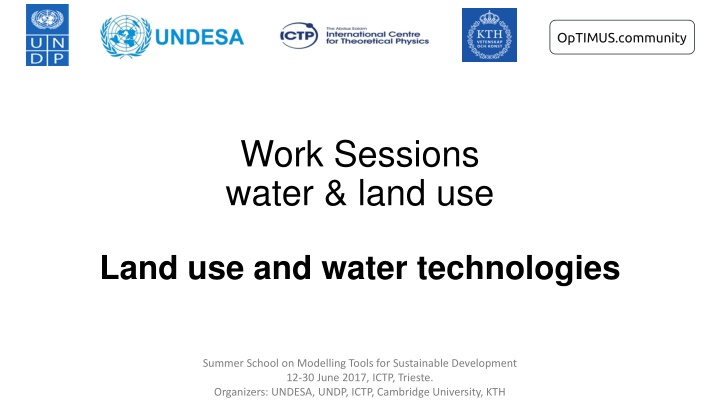
Exploring Sustainable Development through Modelling Tools
This content focuses on a Summer School event held at ICTP, Trieste, covering topics such as representing land classes, water and land use technologies, setting values for ecosystem services, and defining land areas for sustainable development modeling tools. The session overviews, diagrams, and steps presented help participants understand the concepts and methodologies related to sustainable development practices.
Download Presentation

Please find below an Image/Link to download the presentation.
The content on the website is provided AS IS for your information and personal use only. It may not be sold, licensed, or shared on other websites without obtaining consent from the author. If you encounter any issues during the download, it is possible that the publisher has removed the file from their server.
You are allowed to download the files provided on this website for personal or commercial use, subject to the condition that they are used lawfully. All files are the property of their respective owners.
The content on the website is provided AS IS for your information and personal use only. It may not be sold, licensed, or shared on other websites without obtaining consent from the author.
E N D
Presentation Transcript
https://lh6.googleusercontent.com/Ly_PhcwOrV7ieHqPjBUUdqFiAGODtzJmBwrIeHLHNXmO2gAmLok-TdTBr_d3BtnUCDenebmvgE80MCYN8Vorq6tctapX-MHkCI-nBydPkMCIQlU3bY5E3A4URgaFKH9_3Y3ixC7nhttps://lh6.googleusercontent.com/Ly_PhcwOrV7ieHqPjBUUdqFiAGODtzJmBwrIeHLHNXmO2gAmLok-TdTBr_d3BtnUCDenebmvgE80MCYN8Vorq6tctapX-MHkCI-nBydPkMCIQlU3bY5E3A4URgaFKH9_3Y3ixC7n https://lh4.googleusercontent.com/jDjKyzhdhZWMxUNi7z6qAJzpBZEkOBbfd9pxc_hw_VhHxoTvuhQehahE7VFIlqmGgpn-yNdL2HsCN5L4vZpsZzJoIFrGq37CRI-kV8YM3EbnBWnbkWxvjk9tYWPG2bomkqh_um96 https://lh5.googleusercontent.com/QwAyBzI_HrdO1gj0yaFRi0OiqghV8sMirzKBHzFYtGIWVVnBeuDuBR9_JP1vo9XJKYzGCL0sd1ZodqNBZxjvOYILUxRDdlxRQLuJNl1PB5k_6S9avTsqb2zL8U1SbUj7jo_r0pHa OpTIMUS.community Work Sessions water & land use Land use and water technologies Summer School on Modelling Tools for Sustainable Development 12-30 June 2017, ICTP, Trieste. Organizers: UNDESA, UNDP, ICTP, Cambridge University, KTH
Session Overview 1. Representing land classes in the template CLEW model 2. 3. 4. Input and Output activity ratios in Water & Land Technologies Update water use factors for thermal generation Differentiating water and land use technologies parameters used and their meaning units used in the model (parameters and variables) Input and output activity ratios Summer School on Modelling Tools for Sustainable Development 12-30 June 2017, ICTP, Trieste. Organizers: UNDESA, UNDP, ICTP, Cambridge University, KTH 3/17/2025 2
CLEW template model: diagram of the water & land use representation Summer School on Modelling Tools for Sustainable Development 12-30 June 2017, ICTP, Trieste. Organizers: UNDESA, UNDP, ICTP, Cambridge University, KTH
Set a value for ecosystem services (negative variable cost) STEP 4 Setting the area (activity) of Forests, Other land & Pastures and Meadows STEP 2 STEP 1 Limiting the land area of the country Defining the area under cultivation using residual capacity. STEP 3 Summer School on Modelling Tools for Sustainable Development 12-30 June 2017, ICTP, Trieste. Organizers: UNDESA, UNDP, ICTP, Cambridge University, KTH
STEP 1: Land area of the country Use the parameter TotalAnnualActivityUpperLimit & TotalAnnualActivityLowerLimit to introduce the land area of the country This parameter defines the maximum amount of land area available each year. Technology: RNWLND The unit for area used in the model is kha (equivalent to 10 km2). Land system inputs & outputs: no input x LND (land) RNWLND Summer School on Modelling Tools for Sustainable Development 12-30 June 2017, ICTP, Trieste. Organizers: UNDESA, UNDP, ICTP, Cambridge University, KTH 3/17/2025 5
STEP 2: Setting the activity of Forests, Other land & Pastures and Meadows Use the parameter TotalAnnualActivityLowerLimit to define the minimum amount of land use for each land class. NOTE: Implement first to forest and run model. If needed then apply to Pastures and medows. Suggestion: consider that forests and/or pastures&meadows areas may have to decrease over time as crop land and other land expands. Technologies: Forest: LNDFOR001 Pastures and Meadows: LNDMPA001 Other land: LNDOTH001 Land system inputs & outputs: Update variable costs for the technologies: Forest: -0.01 $/kha Pastures and Meadows: -0.05 $/kha Update the capital cost for other land: Other land: 10 $/kha LND (land) LNDFOR LNDFOR001 Summer School on Modelling Tools for Sustainable Development 12-30 June 2017, ICTP, Trieste. Organizers: UNDESA, UNDP, ICTP, Cambridge University, KTH 3/17/2025 6
STEP 3: Defining the areas for crop cultivation Use the parameter ResidualCapacity to introduce the areas under cultivation for each of the 3 main crops (crop 1, 2, 3) and remainder crops (crop 4) for the reference year 2014. This parameter defines how much land is currently equipped for cultivation of the respective crops. Use the rain-fed and/or irrigated crop technologies to specify how much of the land dedicated to a certain crop is under irrigation. Assume that the equipment is gradually retired over a period of 15 years. Technologies: Crops rain-fed: LNDCRP001(2,3,4)R Crops irrigated: LNDCRP001(2,3,4)I Summer School on Modelling Tools for Sustainable Development 12-30 June 2017, ICTP, Trieste. Organizers: UNDESA, UNDP, ICTP, Cambridge University, KTH 3/17/2025 7
STEP 3: Defining the areas for crop cultivation Technologies: Crops rain-fed: LNDCRP001(2,3,4)R Crops irrigated: LNDCRP001(2,3,4)I Update capital costs for the crop technologies: Rainfed: 10 M$/kha Irrigated: 11 M$/kha LNDCRP Land system inputs & outputs: LNDAGR LNDCRP001 agricultural land Summer School on Modelling Tools for Sustainable Development 12-30 June 2017, ICTP, Trieste. Organizers: UNDESA, UNDP, ICTP, Cambridge University, KTH 3/17/2025 8
STEP 4: Safeguarding a minimum water volume for ecosystems services Use the parameter TotalAnnualActivityLowerLimit to define the minimum amount of water that should be generated each year This parameter defines the minimum amount a technology should produce each year Technology Ecosystem services: WATENV001 Update variable costs for the technology assign a negative cost: WATENV001: -0.0001 M$/BCM Water tech inputs & outputs: WATSUR WATENV WATENV001 Summer School on Modelling Tools for Sustainable Development 12-30 June 2017, ICTP, Trieste. Organizers: UNDESA, UNDP, ICTP, Cambridge University, KTH 3/17/2025 9
